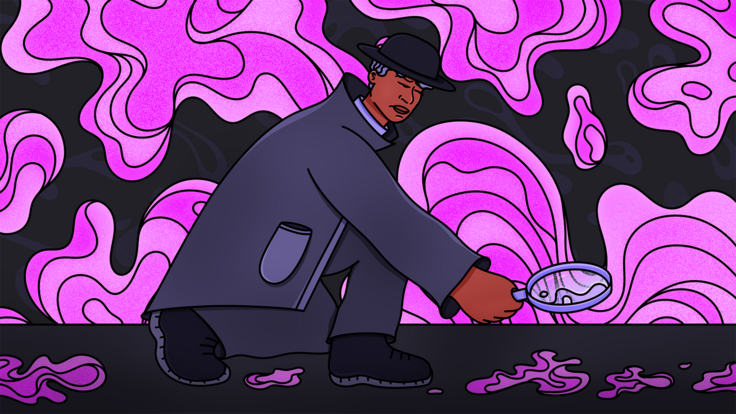We don’t need extra dimensions or parallel universes to have an alternate reality superimposed right on top of our own. Invisible matter is everywhere.
For example, take neutrinos generated by the sun, says Jessie Shelton, a theorist at the University of Illinois at Urbana-Champaign who works on dark sector physics. “We are constantly bombarded with neutrinos, but they pass right through us. They share the same space as our atoms but almost never interact.”
As far as scientists can tell, neutrinos are solitary particles. But what if there is a whole world of particles that interact with one another but not with ordinary atoms? This is the idea behind the dark sector: a theoretical world of matter existing alongside our own but invisible to the detectors we use to study the particles we know.
“Dark sectors are, by their very definition, built out of particles that don't interact strongly with the Standard Model,” Shelton says.
The Standard Model is a physicist’s field guide to the 17 particles and forces that make up all visible matter. It explains how atoms can form and why the sun shines. But it cannot explain gravity, the cosmic imbalance of matter and antimatter, or the disparate strengths of nature's four forces.
On its own, an invisible world of dark sector particles cannot solve all these problems. But it certainly helps.
The main selling point for the dark sector is that the theories comprehensively confront the problem of dark matter. Dark matter is a term physicists coined to explain bizarre gravitational effects they observe in the cosmos. Distant starlight appears to bend around invisible objects as it traverses the cosmos, and galaxies spin as if they had five times more mass than their visible matter can explain. Even the ancient light preserved in cosmic microwave background seems to suggest that there is an invisible scaffolding on which galaxies are formed.
Some theories suggest that dark matter is simple cosmic debris that adds mass—but little else—to the complexity of our cosmos. But after decades of searching, physicists have yet to find dark matter in a laboratory experiment. Maybe the reason scientists haven’t been able to detect it is that they’ve been underestimating it.
“There is no particular reason to expect that whatever is going on in the dark sector has to be as simple as our most minimal models,” Shelton says. “After all, we know that our visible world has a lot of rich physics: Photons, electrons, protons, nuclei and neutrinos are all critically important for understanding the cosmology of how we got here. The dark sector could be a busy place as well.”
According to Shelton, dark matter could be the only surviving particle out of a similarly complicated set of dark particles.
“It could even be something like the proton, a bound state of particles interacting via a very strong dark force. Or it could even be something like a hydrogen atom, a bound state of particles interacting via a weaker dark force,” she says.
Even if terrestrial experiments cannot see these stable dark matter particles directly, they might be sensitive to other kinds of dark particles, such as dark photons or short-lived dark particles that interact strongly with the Higgs boson.
“The Higgs is one of the easiest ways for the Standard Model particles to talk to the dark sector,” Shelton says.
As far as scientists know, the Higgs boson is not picky. It may very well interact will all sorts of massive particles, including those invisible to ordinary atoms. If the Higgs boson interacts with massive dark sector particles, scientists should find that its properties deviate slightly from the Standard Model’s predictions. Scientists at the Large Hadron Collider are precisely measuring the properties of the Higgs boson to search for unexpected quirks that could open a gateway to new physics.
At the same time, scientists are also using the LHC to search for dark sector particles directly. One theory is that at extremely high temperatures, dark matter and ordinary matter are not so different and can transform into one another through a dark force. In the hot and dense early universe, this would have been quite common.
“But as the universe expanded and cooled, this interaction froze out, leaving some relic dark matter behind,” Shelton says.
The energetic particle collisions generated by the LHC imitate the conditions that existed in the early universe and could unlock dark sector particles. If scientists are lucky, they might even catch dark sector particles metamorphosing into ordinary matter, an event that could materialize in the experimental data as particle tracks that suddenly appear from no apparent source.
But there are also several feasible scenarios in which any interactions between the dark sector and our Standard Model particles are so tiny that they are out of reach of modern experiments, according to Shelton.
"These ‘nightmare’ scenarios are completely logical possibilities, and in this case, we will have to think very carefully about astrophysical and cosmological ways to look for the footprints of dark particle physics,” she says.
Even if the dark sector is inaccessible to particle detectors, dark matter will always be visible through the gravitational fingerprint it leaves on the cosmos.
“Gravity tells us a lot about how much dark matter is in the universe and the kinds of particle interactions dark sector particles can and cannot have,” Shelton says. “For instance, more sensitive gravitational-wave experiments will give us the possibility to look back in time and see what our universe looked like at extremely high energies, and could maybe reveal more about this invisible matter living in our cosmos.”














